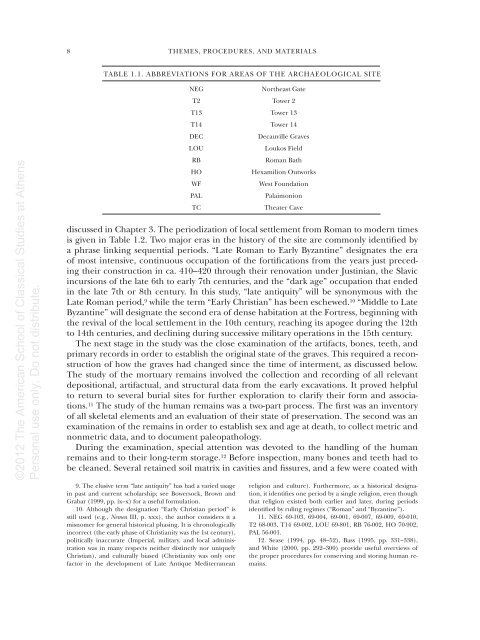The Roman and Byzantine Graves and Human Remains
The Roman and Byzantine Graves and Human Remains
The Roman and Byzantine Graves and Human Remains
Create successful ePaper yourself
Turn your PDF publications into a flip-book with our unique Google optimized e-Paper software.
©2012 <strong>The</strong> American School of Classical Studies at Athens<br />
Personal use only. Do not distribute.<br />
8 themes, ProCedures, <strong>and</strong> materials<br />
table 1.1. abbreviations For areas oF the arChaeologiCal site<br />
neg northeast gate<br />
t2 tower 2<br />
t13 tower 13<br />
t14 tower 14<br />
deC decauville graves<br />
lou loukos Field<br />
rb roman bath<br />
ho hexamilion outworks<br />
WF West Foundation<br />
Pal Palaimonion<br />
tC theater Cave<br />
discussed in Chapter 3. the periodization of local settlement from roman to modern times<br />
is given in table 1.2. two major eras in the history of the site are commonly identified by<br />
a phrase linking sequential periods. “late roman to early byzantine” designates the era<br />
of most intensive, continuous occupation of the fortifications from the years just preceding<br />
their construction in ca. 410–420 through their renovation under Justinian, the slavic<br />
incursions of the late 6th to early 7th centuries, <strong>and</strong> the “dark age” occupation that ended<br />
in the late 7th or 8th century. in this study, “late antiquity” will be synonymous with the<br />
late roman period, 9 while the term “early Christian” has been eschewed. 10 “middle to late<br />
byzantine” will designate the second era of dense habitation at the Fortress, beginning with<br />
the revival of the local settlement in the 10th century, reaching its apogee during the 12th<br />
to 14th centuries, <strong>and</strong> declining during successive military operations in the 15th century.<br />
the next stage in the study was the close examination of the artifacts, bones, teeth, <strong>and</strong><br />
primary records in order to establish the original state of the graves. this required a reconstruction<br />
of how the graves had changed since the time of interment, as discussed below.<br />
the study of the mortuary remains involved the collection <strong>and</strong> recording of all relevant<br />
depositional, artifactual, <strong>and</strong> structural data from the early excavations. it proved helpful<br />
to return to several burial sites for further exploration to clarify their form <strong>and</strong> associations.<br />
11 the study of the human remains was a two-part process. the first was an inventory<br />
of all skeletal elements <strong>and</strong> an evaluation of their state of preservation. the second was an<br />
examination of the remains in order to establish sex <strong>and</strong> age at death, to collect metric <strong>and</strong><br />
nonmetric data, <strong>and</strong> to document paleopathology.<br />
during the examination, special attention was devoted to the h<strong>and</strong>ling of the human<br />
remains <strong>and</strong> to their long-term storage. 12 before inspection, many bones <strong>and</strong> teeth had to<br />
be cleaned. several retained soil matrix in cavities <strong>and</strong> fissures, <strong>and</strong> a few were coated with<br />
9. the elusive term “late antiquity” has had a varied usage<br />
in past <strong>and</strong> current scholarship; see bowersock, brown <strong>and</strong><br />
grabar (1999, pp. ix–x) for a useful formulation.<br />
10. although the designation “early Christian period” is<br />
still used (e.g., Nemea iii, p. xxx), the author considers it a<br />
misnomer for general historical phasing. it is chronologically<br />
incorrect (the early phase of Christianity was the 1st century),<br />
politically inaccurate (imperial, military, <strong>and</strong> local administration<br />
was in many respects neither distinctly nor uniquely<br />
Christian), <strong>and</strong> culturally biased (Christianity was only one<br />
factor in the development of late antique mediterranean<br />
religion <strong>and</strong> culture). Furthermore, as a historical designation,<br />
it identifies one period by a single religion, even though<br />
that religion existed both earlier <strong>and</strong> later, during periods<br />
identified by ruling regimes (“roman” <strong>and</strong> “byzantine”).<br />
11. neg 69-103, 69-004, 69-001, 69-007, 69-009, 69-010,<br />
t2 68-003, t14 69-002, lou 69-801, rb 76-002, ho 70-902,<br />
Pal 56-001.<br />
12. sease (1994, pp. 48–52), bass (1995, pp. 331–338),<br />
<strong>and</strong> White (2000, pp. 292–300) provide useful overviews of<br />
the proper procedures for conserving <strong>and</strong> storing human remains.
















